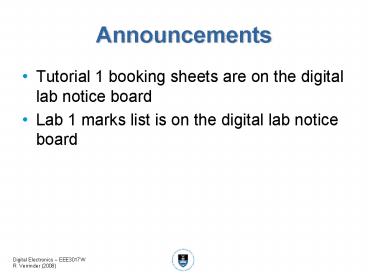Digital Electronics EEE3017W - PowerPoint PPT Presentation
1 / 10
Title:
Digital Electronics EEE3017W
Description:
Announcements. Tutorial 1 booking sheets are on the digital lab notice board. Lab 1 marks list is on the digital lab notice board. Clocking Strategies ... – PowerPoint PPT presentation
Number of Views:263
Avg rating:3.0/5.0
Title: Digital Electronics EEE3017W
1
Announcements
- Tutorial 1 booking sheets are on the digital lab
notice board - Lab 1 marks list is on the digital lab notice
board
2
Clocking Strategies
- As discussed earlier, circuit speed is often
critical in circuit design - Double edged clocking is sometimes used to
effectively double the clocking speed of the
circuit without doubling the clock speed - This uses both the rising and falling edges of
the clock to trigger circuit events
3
Double edge clocking
- Problems with double edge clocking include
- Non-synchronous resetting
- Complex timing patterns make circuit analysis
difficult - Set up and hold times can be violated with fine
tuned timing
4
Double edge clocking
- Recommended solution clock the circuit at twice
the frequency
5
Level and Edge Triggered Devices
- A level triggered flip allows the state of the
data input to be captured through out the entire
active clock cycle - How can this generate possible errors?
6
Level Triggered Devices
- Consider this design
- The d-type flip-flop is level triggered
- The output from the flip-flop is fed into a
combinational logic circuit which feeds its
signal back to the input
- This will cause the output to oscillate as long
as the clock is active - This is known as a Race Condition
7
Level Triggered Devices
- Consider this design
- A d-type flip-flop is used to capture the output
of some combinational logic - The flip-flop is level triggered
- Any possible variations on the input of the
flip-flop will be propagated to the output - The flip-flop acts as a transparent latch
- In most cases this is undesired behavior
8
Edge Triggered Devices
- For most synchronous design it is recommended
that you use edge triggered devices
9
Summary of Design Rules
- Tie all unused input to the appropriate voltage
level - Keep designs synchronous by making asynchronous
inputs synchronous if possible - Use edge triggered devices
- Avoid gating clocks
- Always provide a system reset to set circuit to a
known state
10
What have we covered in this Module?
- Basic Logic Gates
- De Morgan's Rules and General Boolean Identities
- Karnaugh Maps
- Combinational and Sequential Circuits
- Present State-Next State Diagrams
- Algorithmic State Machine Design
- One Flip-Flop per State
- Practical Logic Design Rules































